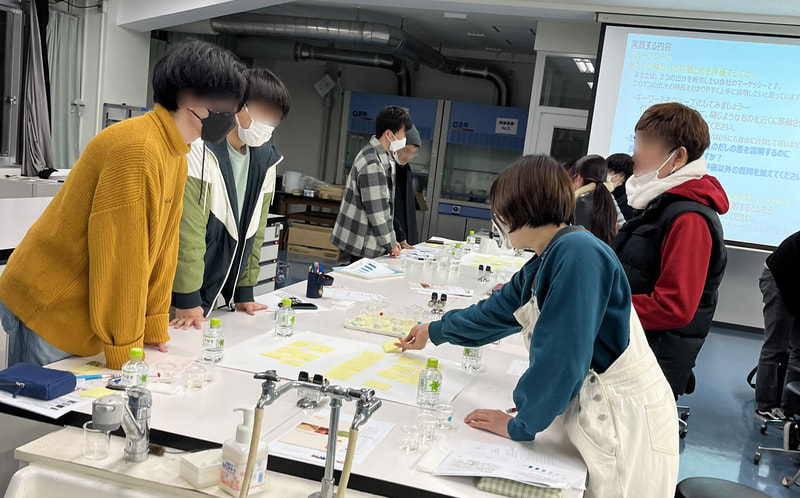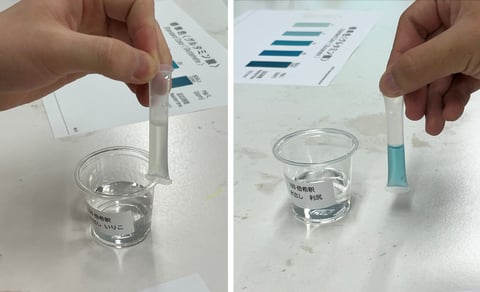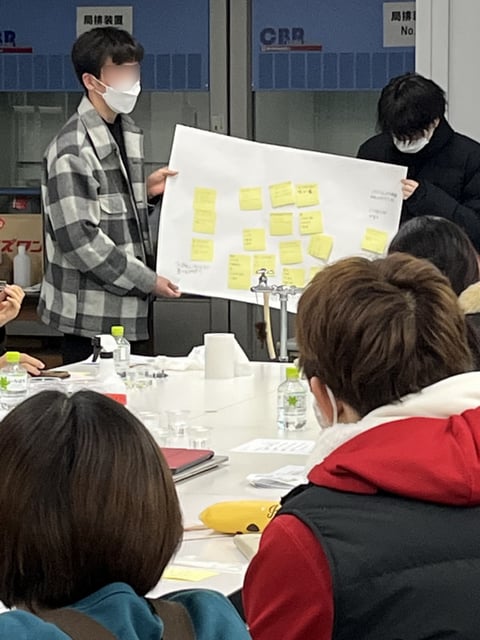Students of Tohoku University took a scientific approach to Japanese food culture
January 2023

Your sense of "tasty" depends on your preferences, the physical condition, the atmosphere, and the food culture to which you belong and so on. So, is it possible to scientifically evaluate this sensation? In recent years, scientists around the world are working to identify the mechanisms of " deliciousness" scientifically and to apply the findings to our daily lives. Efforts to analyze the elements that make up deliciousness, such as ingredients and textures, and to create new tastiness are also underway.
On January 26, 2023, the Umami Information Center (UIC) held a class on the scientific approach to washoku and umami at Tohoku University. This lecture was part of the "Basic Seminar: Understanding Japanese Food Culture Scientifically," in which lecturers from inside and outside Tohoku University talked about washoku from their fields.
UIC had a lecture and practical classes focusing on dashi with rich umami, which works as the taste base of washoku. The class was attended by 25 first-year students from various faculties, including law, medicine, education, and literature, etc. They worked in groups to observe dashi ingredients, taste foods rich in umami, and conduct experiments. The two-hour lecture by Ms. Sawa, a UIC director proceeded with the following contents.
Sense umami, the fifth taste
The class opened with a lecture of basic study of what umami is. While listening to the explanation, students tasted umami rich foods such as dried tomatoes and katsuo dashi to understand the characteristics of umami.
The main umami substances are glutamate, inosinate and guanylate. Umami is sensed far more strongly when these are present not individually, but when glutamate presents with inosinate or guanylate which are nucleic acid umami substances. This is referred to as umami synergy. The students experienced the phenomena by tasting.
Observation of dashi ingredients / Finding key words
The students observed niboshi - dried sardines and several kombu which are the basic dashi ingredients of washoku. They smelled and felt these dashi ingredients. Then they tasted water extracted dashi, made by rishiri kombu, rausu kombu, and niboshi, and wrote some keywords for the characteristics of each dashi on sticky notes.
Group Work: Experiment to check the concentration of umami substance (glutamate)
This is an experiment to compare the amount of glutamate in the three types of "water extracted dashi" mentioned above (rishiri kombu dashi, rausu kombu dashi, and niboshi dashi). Using a reagent, the students confirmed that the more glutamate in diluted dashi, the more blue the sample turned. In this experiment, although the two dashi have in common that they are both "umami rich dashi," the niboshi dashi, which contains a lot of inosinate - nucleotide umami substances, does not turned blue as much as the kombu dashi does. The students observed the results with great interest. After that, a brief explanation was given on how sensory evaluations are used to develop new products in food companies, and group work was conducted in the latter half of the class.

Group Work and Presentations
The assignment was given to the students; If you were the products managers of marketing in a company who want to launch three types of dashi – made of rishiri kombu, rausu kombu and niboshi. How do you explain the characteristics of them in an easy-to-understand way?
The students worked together in groups using the sticky notes with “characteristics of each dashi” which they prepared in the first half of the class. They discussed to find the keyword elements in common among the characteristics for each dashi and categorized the keywords. Finally, they determined the best keyword as the product concept to explain the characteristics and differential advantages of each dashi. Then they made a presentation by group.

In the post-lecture questionnaire, we received a lot of lively impressions from the students. Many wrote that through the group works and presentations by other groups, they recognized how differently people perceive tastiness.
- After listening to another groups' comments, I felt that whether or not people use dashi in their daily cooking may be reflected in their preferences for dashi.
- I smelled variety of kombu, but only hidaka kombu made me imagine the taste from its smell. I understood that people taste by memory, too.
- Through the taste comparison of dashi and the discussion in group works, I could understand what umami is.
- We all tasted the same items, but our taste impressions were very different. I could see what element of flavor each person valued in dashi. I felt the depth of the dashi world.
UIC hopes that all participants will make use of the experiences gained in this class in their fields and in their daily lives.
